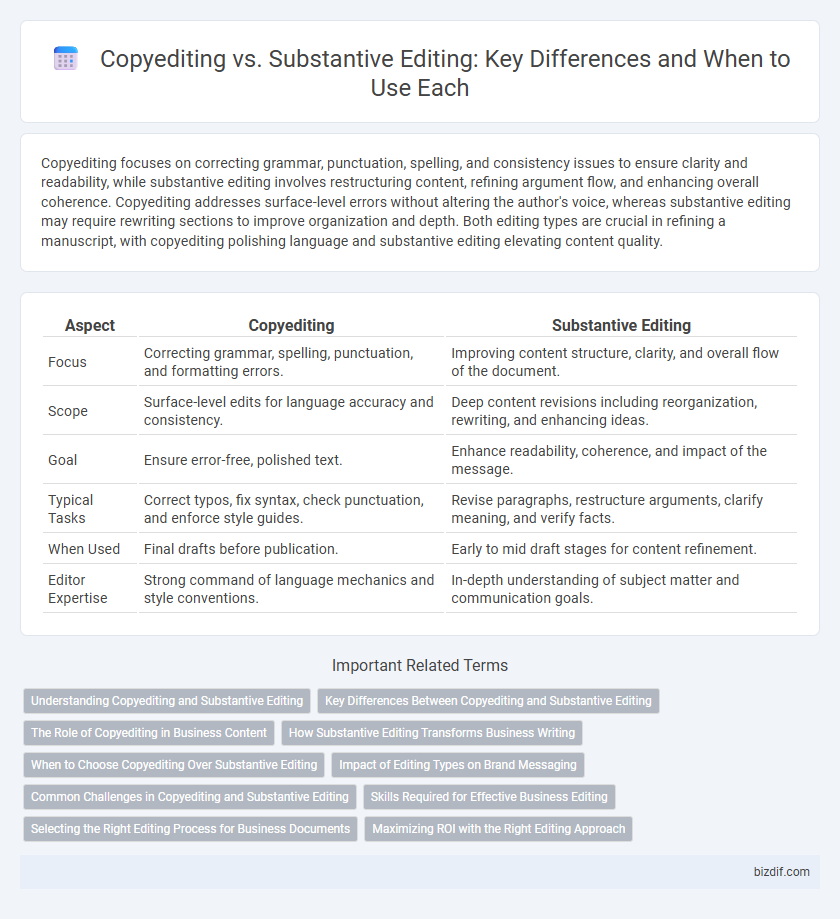Copyediting focuses on correcting grammar, punctuation, spelling, and consistency issues to ensure clarity and readability, while substantive editing involves restructuring content, refining argument flow, and enhancing overall coherence. Copyediting addresses surface-level errors without altering the author's voice, whereas substantive editing may require rewriting sections to improve organization and depth. Both editing types are crucial in refining a manuscript, with copyediting polishing language and substantive editing elevating content quality.
Table of Comparison
| Aspect | Copyediting | Substantive Editing |
|---|---|---|
| Focus | Correcting grammar, spelling, punctuation, and formatting errors. | Improving content structure, clarity, and overall flow of the document. |
| Scope | Surface-level edits for language accuracy and consistency. | Deep content revisions including reorganization, rewriting, and enhancing ideas. |
| Goal | Ensure error-free, polished text. | Enhance readability, coherence, and impact of the message. |
| Typical Tasks | Correct typos, fix syntax, check punctuation, and enforce style guides. | Revise paragraphs, restructure arguments, clarify meaning, and verify facts. |
| When Used | Final drafts before publication. | Early to mid draft stages for content refinement. |
| Editor Expertise | Strong command of language mechanics and style conventions. | In-depth understanding of subject matter and communication goals. |
Understanding Copyediting and Substantive Editing
Copyediting focuses on correcting grammar, punctuation, spelling, and consistency to ensure clarity and readability, while substantive editing involves restructuring content, enhancing flow, and improving overall coherence and argumentation. Understanding copyediting requires attention to detailed language mechanics, whereas substantive editing demands a comprehensive grasp of the text's purpose and audience to make meaningful content changes. Both processes are essential in the editorial workflow to produce polished, well-organized, and effective communication.
Key Differences Between Copyediting and Substantive Editing
Copyediting focuses on correcting grammar, punctuation, spelling, and consistency, ensuring the text is polished and error-free. Substantive editing involves a deeper revision of content structure, clarity, and overall flow, addressing issues such as organization, coherence, and argument strength. The key difference lies in the scope: copyediting fine-tunes language mechanics while substantive editing reshapes and enhances the fundamental message and presentation of the manuscript.
The Role of Copyediting in Business Content
Copyediting ensures business content is clear, consistent, and error-free by focusing on grammar, punctuation, and style adherence, which enhances professionalism and readability. It strengthens brand messaging by maintaining uniform tone and terminology across documents, boosting client trust and engagement. Effective copyediting reduces miscommunication risks and improves overall content quality, supporting business growth and credibility.
How Substantive Editing Transforms Business Writing
Substantive editing transforms business writing by reshaping content structure, enhancing clarity, and aligning messaging with strategic goals, resulting in impactful communication that drives decision-making. Unlike copyediting, which focuses on grammar and style, substantive editing delves into the organization, tone, and flow of the document to ensure coherence and relevance to the target audience. This process significantly improves reader engagement and the overall effectiveness of business documents such as reports, proposals, and presentations.
When to Choose Copyediting Over Substantive Editing
Choose copyediting over substantive editing when the manuscript requires precise grammar, punctuation, and style correction without altering the core content or structure. Copyediting is ideal for near-final drafts needing refinement for clarity and consistency rather than major content revisions. Opt for substantive editing only if the document demands comprehensive reorganization, content enhancement, or fact-checking beyond surface-level corrections.
Impact of Editing Types on Brand Messaging
Copyediting ensures brand messaging is clear and consistent by correcting grammar, punctuation, and style, which maintains professionalism and reader trust. Substantive editing reshapes content structure and tone, enhancing the brand's voice to align with strategic communication goals and audience engagement. Both editing types significantly impact how effectively a brand's message resonates and influences perception.
Common Challenges in Copyediting and Substantive Editing
Copyediting challenges often include ensuring grammatical accuracy, consistency in style, and eliminating typographical errors while preserving the author's voice. Substantive editing involves deeper restructuring to enhance clarity, coherence, and logical flow, which can be difficult when balancing significant content changes with maintaining the original intent. Both require keen attention to detail and effective communication between editor and author to address misunderstandings and avoid unintended alterations.
Skills Required for Effective Business Editing
Effective business editing demands a blend of detailed copyediting skills, such as grammar, punctuation, and consistency checks, alongside substantive editing abilities, including structural refinement and clarity enhancement. Mastery in linguistic precision and an eye for organizational coherence ensure that the document's message is clear, professional, and aligned with business objectives. Proficiency in these combined editing techniques significantly improves communication impact and stakeholder engagement.
Selecting the Right Editing Process for Business Documents
Copyediting ensures grammatical accuracy, consistency, and clarity in business documents by correcting spelling, punctuation, and syntax errors without altering the original content. Substantive editing involves reorganizing, refining tone, and enhancing structure to improve overall communication effectiveness and message coherence. Selecting the right editing process depends on the document's purpose, audience, and the depth of revisions required to meet professional standards.
Maximizing ROI with the Right Editing Approach
Maximizing ROI in publishing requires choosing between copyediting and substantive editing based on project goals and budget constraints. Copyediting enhances clarity, grammar, and consistency, ensuring error-free content, while substantive editing restructures and refines the narrative for greater impact and readability. Aligning the editing approach with desired outcomes optimizes resource allocation and elevates content quality, driving better reader engagement and market success.
Copyediting vs Substantive Editing Infographic

 bizdif.com
bizdif.com